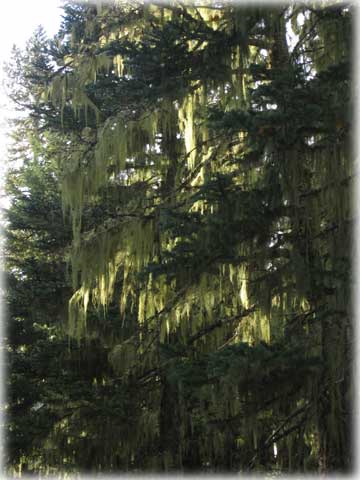 By Sarah Red-Laird February 19, 2007
This colorful list of names is not ingredients' for a witch's stew, but little friends we have right here in our back yard. As fascinating looking as they sound, we are talking about lichens.
What is lichen? We have all heard the word uttered, have definitely seen it around, and some of us can even identify a few of the 500 species we have here in southeast Alaska. But what is lichen exactly? What does it do, what is it good for? In this article, we'll explore the wide world of lichens. Lichen is a symbiotic relationship between fungus and algae, or cyanobacteria. There are four basic categories: Foliose, the flat leafy lichens; Crustose, crusty and hard lichens that are found on rocks, or buried in tree bark; Fruticose, mini shrub like or long and flowing lichens; and Squamulose, scaly lichens that look like a cross between foliose and crustose. Lichen come in a most remarkable array of colors. Elegant sunburst lichen, which prefers rocky surfaces, is bright orange and resembles a flattened sea coral. Devil's Matchstick, which loves to strike up on mossy boulders, has a shinny black head attached to a sea foam green stock. British soldiers have a similar stock, but with a flaming lipstick red top. Tundra spaghetti looks just like it sounds, long white tubes, which grow in the alpine zone in southeast Alaska. Lungwort was given its name by medieval healers, because its texture so closely resembles lung tissue, even though it is a bright, rich green. Lichens are a pioneer species. They often grow where nothing else can, and pave the way for other species to colonize, as well. You may often see lichens on bare rock, desert or glacial sand, dead wood, animal bones, or rusty metal. You won't notice them changing much, though. Most lichen colonies grow less than a millimeter per year. Growing slowly, but surely, some lichens are thought to be the oldest living things on earth. There are two categories of uses for lichen, primary and secondary. The primary uses for lichens are as animal food and shelter, and air quality testing. Flying squirrels, chickadees, hummingbirds, and warblers make their nests out of lichens such as witch's hair, horsehair, and Methuselah's beard lichens. Sitka black-tailed deer and flying squirrels eat horsehair and witch's hair lichens when all other food is buried deep beneath the snow in our harsh winter months. Mountain goats survive on cabbage lungwort lichen in the snowy months. And a caribou's winter diet is 90% reindeer moss lichen. Some lichens, such as; beaded tube lichen, lettuce lichen, varied rag lichen, and our familiar friend, witches hair lichen, monitor air quality here in southeast Alaska. To feed themselves, lichens suck water and moisture directly out of the air like a sponge, absorbing nutrients and, incidentally, pollutants that may be floating around as well. These lichens can be tested, and are indicators to biologists how much pollution is in the air at any given site. If the air becomes too laden down with smog, our sensitive lichen friends will not survive. If you notice a plethora of lichens in your area, take a deep breath, your air is fresh and clean. Historically, secondary uses for lichens have been shampoo, a substitute for hops in beer, creating face paint, embalming mummies, emergency food during famines, baby diapers, bandages, feminine hygiene supplies, and making brandy. Locally, pigment from southeast Alaska's lichens was extracted and used for dying fiber for Chilkat blankets. Now-a-days, lichens secondary uses are mostly woolen dye pigments, fancy French perfumes, and ingredients in modern medicine. However, because lichens grow so slowly, some species are quickly becoming extinct due to mass harvesting. So, the next time you hike on your favorite forested trail, pass by a boulder, or a grave stone, or trek up to one of our local glaciers, take a quick look around for some witches hair, a devil's matchstick, a pixie cup, or an elegant sunburst, and appreciate them for being more than just a whimsical name or a colorful splotch.
with the Taiya Inlet Watershed Council, Skagway, AK Publish A Letter on SitNews Read Letters/Opinions
|
||
